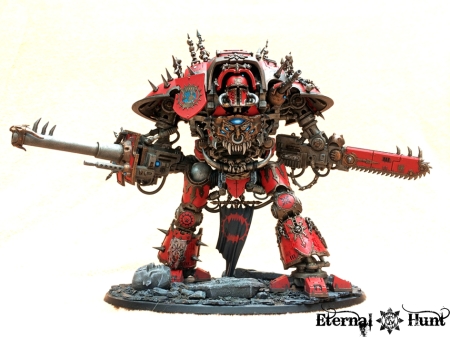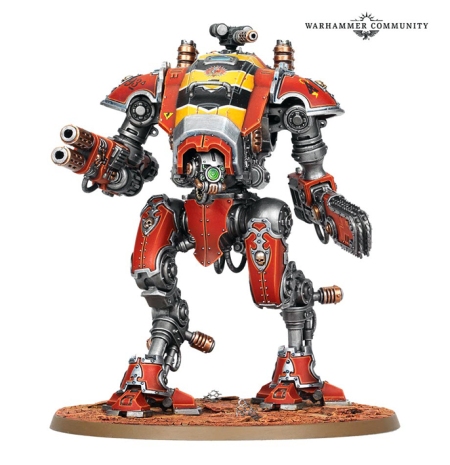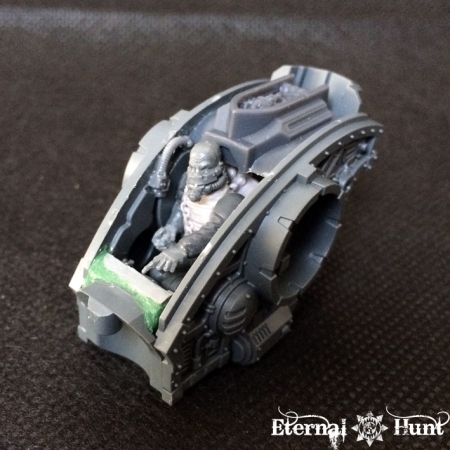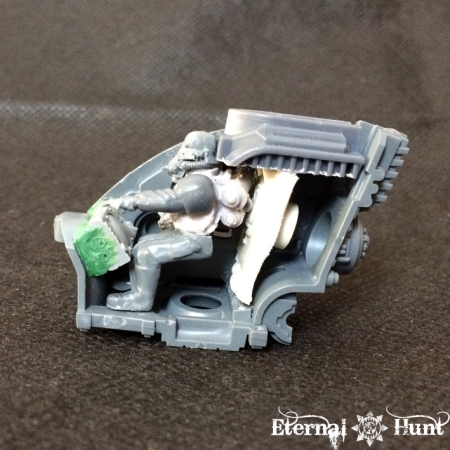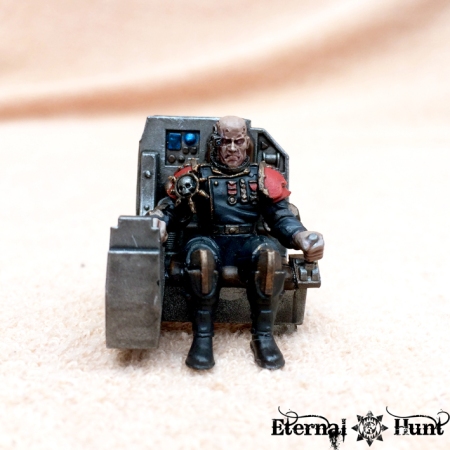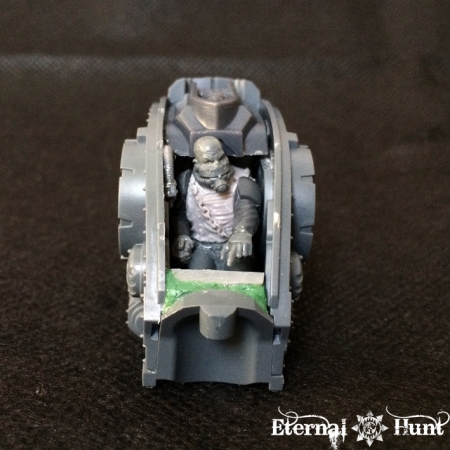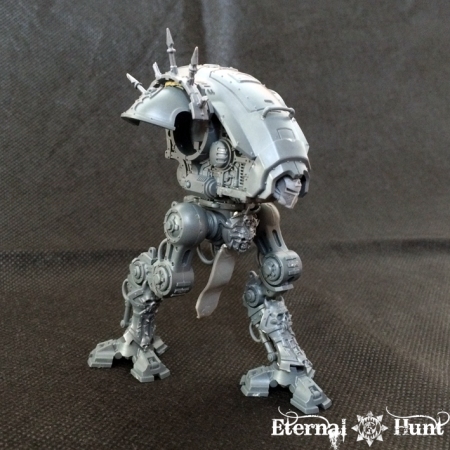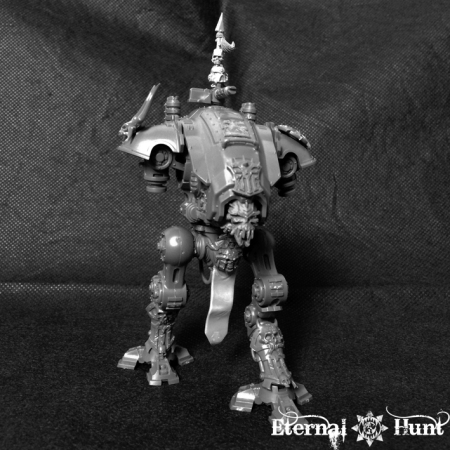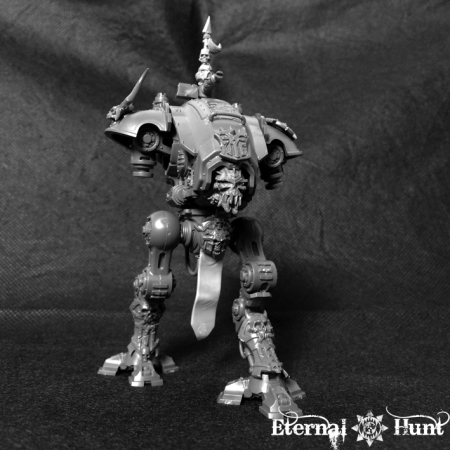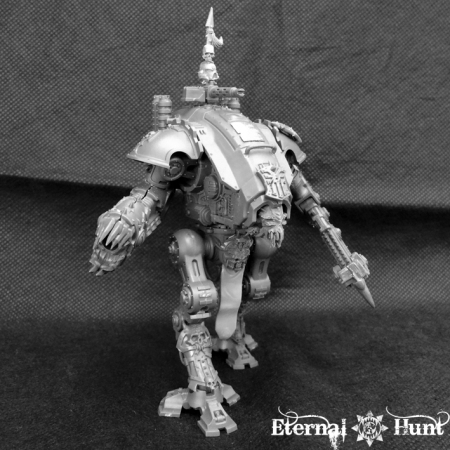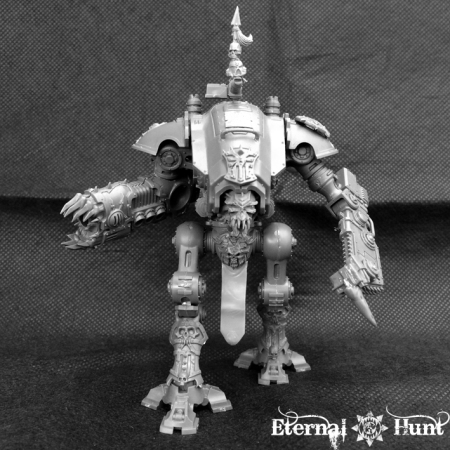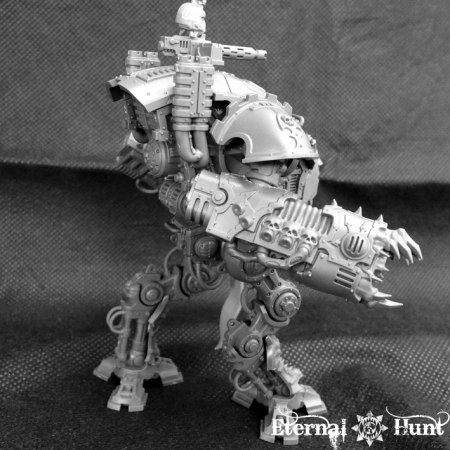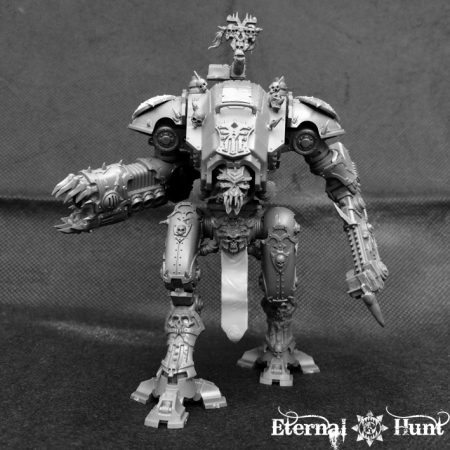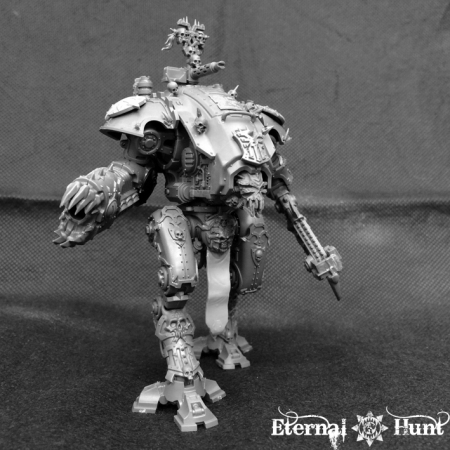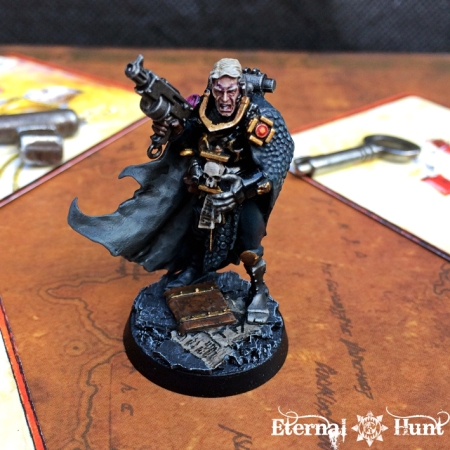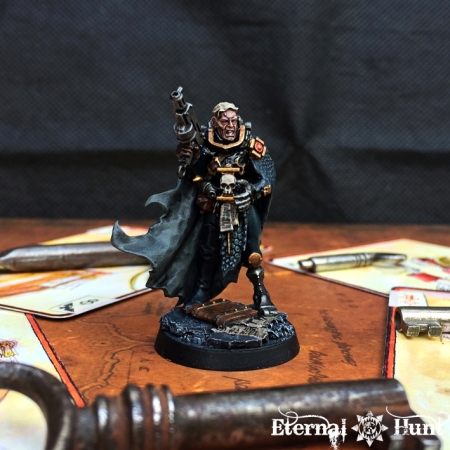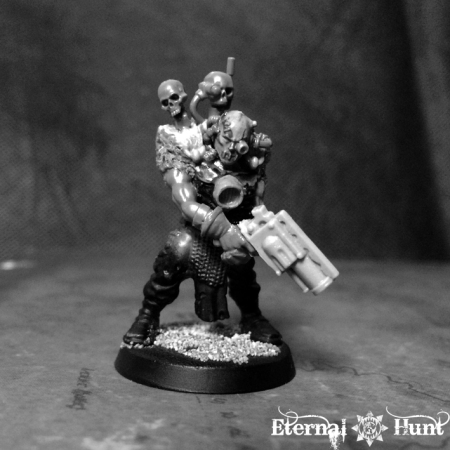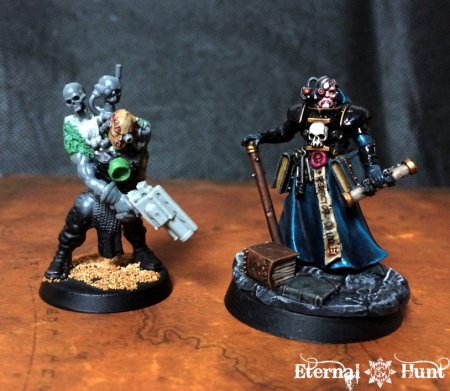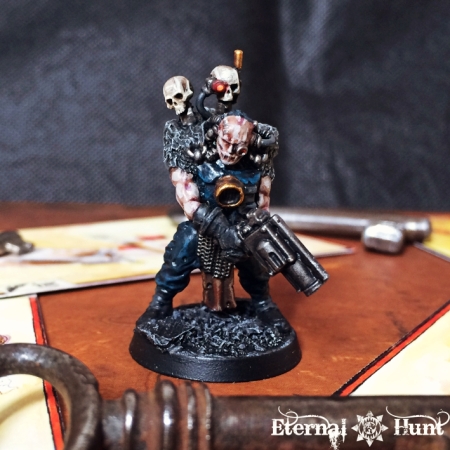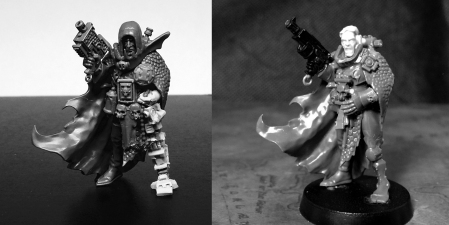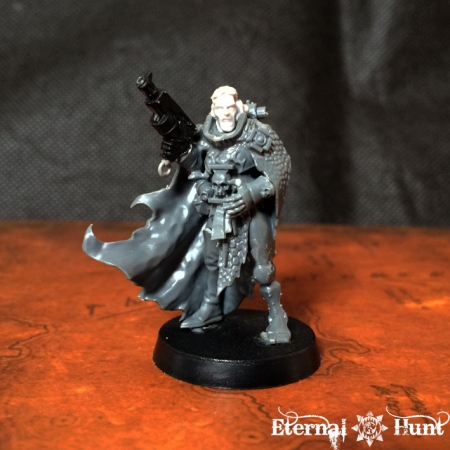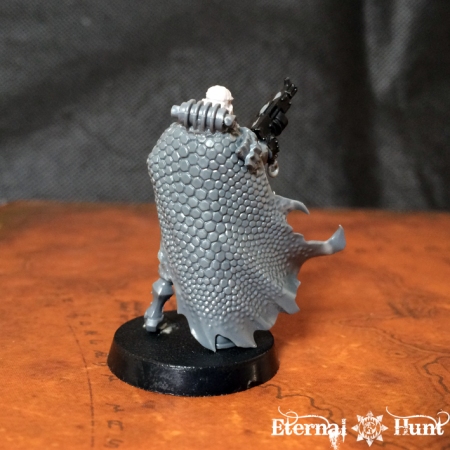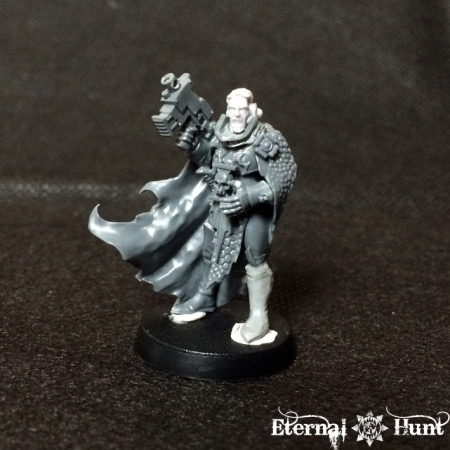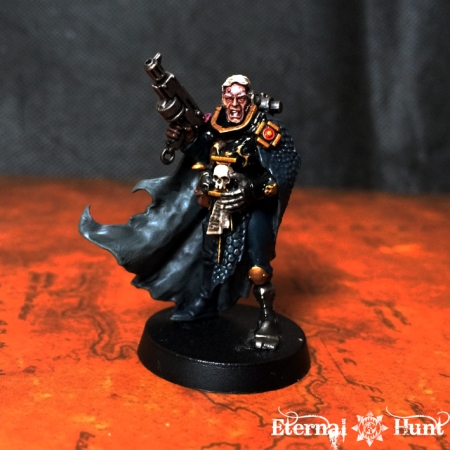Most of my recent hobby time has been spent working on characters for my INQ28 collection — and rightly so, because I have been having a blast powering through all of those neglected models that have sat in the cupboard of shame for ages.
But the ruinous powers demand observance every once in a while, so to prove that my allegiance still lies firmly with the pantheon, let me show you something related to my other big ongoing hobby project – Khorne’s Eternal Hunt – again. So what is this about?
Long time readers of this blog might remember this guy: Gilgamesh, the Warrior King:
Building and painting an allied Renegade Knight for my World Eaters easily remains one of my most complex and involved hobby projects so far — and one that, incidentally, even got me mentioned on the GW page.
In fact, if you want to read up on Gilgamesh, a comprehensive collection of posts on the project can be found if you follow the link above this picture.
But why bring Gilgamesh up yet again? Don’t I have anything new to show you? The reason is that I immediately had to think of the Warrior King when the Forgebane boxed set was released fairly recently:
Arguably the star of the set are the two smaller knights – Armiger Warglaives – that come with it. They are intended as smaller men-at-arms to escort and protect the bigger Imperial Knights, and in that function, they make for a rather exciting addition to the severely limited options of an Imperial Knight player (Forgeworld variants notwithstanding). The models are also rather lovely, which made me feel that I would need at least one of those Armigers in my collection at some point…
But I decided to hold off on yet another boxed set purchase — until a recent visit to Berlin not only provided me with the opportunity to visit the massive temple of hobby goodness that is Battlefield Berlin, but also presented the chance of getting the AdMech half of the Forgebane set for a pretty good price — and I caved in, of course, taking all of those lovely sprues home and poring over them. The fact that the other AdMech models from the set are also rather lovely did, of course, help 😉
But back to the Armigers, because it was clear to me that I would have to turn them to the service of the ruinous powers: They would become servants of the Warrior King, accompanying him in battle, scouting ahead and softening up his enemies.
Meanwhile, with fellow hobbyists extraordinaire Biohazard and Jeff Tibbetts (of Queen Bee fame) already on the game as well, I knew I needed to give it my best shot to come up with something suitably cool 😉
So where to start? In a slightly weird parallel to my approach when originally building Gilgamesh, I actually focused on a slightly unexpected question that nevertheless fascinated me: How to add a pilot to the Armiger Warglaive interior?
Then again, I am in love with the thoughts of these machines actually being defined, to some degree, by the pilots that ride them to battle, and seeing how adding a pilot and a cockpit to the model remains one of my favourite parts of my Imperial Knight project, it probably shouldn’t surprise you to learn that I was feeling just the same way this time around.
That being said, the Armiger is a fair bit smaller than the Imperial Knight, making for an even bigger exercise in managing real estate inside that torso. The good news was that fellow hobbyist Biohazard had already come up with a supremely clean and elegant solution for building a cockpit for the Armiger, using Sentinel and Storm Talon cockpit bitz. The bad news was that I didn’t have access to any of the bitz he used, so I had to cobble something together with the bitz I had.
So here’s what I have to show for my efforts:
As I had already expected, lack of space was even more of a problem this time around. I managed to get it all weged in there somehow, but it was a close thing. From a structural perspective, the Armiger cockpit basically mirrors my build for the bigger Knight’s cockpit, albeit in a slightly stripped down fashion. Here’s a side view, showing you the basic setup, warts and all:
Admittedly, it all looks pretty messy, but once both side walls are in place, all the rough bits of the conversion actually get covered up rather nicely. And while I initially regretted not even building an actual seat underneath the pilot, it turned out the entire area’s not even visible anyway, after everything has been assembled — in fact, it’s such a tight fit that I even had to file the side of the pilot’s right arm flat in order for him to fit flushly into the cockpit.
As for the bitz I used, the part used to represent the engine was a bit of a surprise discovery: It’s a part from the vox relay that comes with the Sector Imperialis Objectives kit. All it needed was a bit of shaving down, and it fit like a charm, and even provided a bit of a headrest. The pilot was mainly assembled around a sentinel pilot body — the torso seemed too pedestrian for me, so I cut it off and replaced it with a Vraksian Renegade Militia torso that had the added benefit of looking a bit like a flight jacket, which seemed like an excellent fit for a pilot 😉 I used some Cadian arms and spliced together a head from a Skitarii Vanguard helmet and an Empire flagellant head (for that slightly unhinged look I thought matched a follower of chaos). My overall aim was to come up with a pilot that resembles Barron Harrowthorne, Gilgamesh’s pilot, to a certain degree, while also looking like his subordinate:
I think the finished pilot works rather well in that respect — I regretted not actually having built a seat underneath him at first, but it turned out you don’t really see anything except for the actual pilot once the whole cockpit is assembled:
In fact, I even had to file the side of the pilot’s right arm flat in order for him to fit into the cockpit 😉 Oh, before I forget, the controls for the Armiger are actually a shaved down console from a Space Marine Rhino interior panel:
So with the pilot out of the way, I only had the entire rest of the model left to build, right? 😉
I started by simply working on the Armiger’s basic assembly. It’s astonishing how much the Armiger works like a smaller Imperial Knight, from a structural perspective, with the whole assembly process eerily familiar, yet slightly simplified. So in addition to actually getting the model’s basic structure built, I was also able to start throwing bitz at the model to see what would stick:
I quickly discovered that some vambraces from the plastic Bloodthirster made for almost perfect leg armour, both because they were a perfect fit and because they provided some instant Khornification 😉 In fact, decorating the Armiger is quite a bit easier than working with the Imperial Knight, as far more Dreadnought (or even infantry) bitz are rendered viable for the conversion by the slightly smaller scale.
As a fun surprise, the head from the FW World Eaters Dreadnought Augustus b’Raass gave me last year (and that is rapidly turning into one of my favourite 40k bitz, see here and here) worked rather nicely here as well, although there were several alternatives I also wanted to look at (the simplest option seems to be to just use Defiler face masks on top of the stock Armiger head).
I also decided to add a “mini-banner” between the legs as an opportunity to include some personal heraldry and battle honours. Granted, Armigers are only men-at-arms, but I still think it’s a nice touch for a machine that has probably been serving the ruinours powers for a couple of centuries, at the very least.
During further experimentation, I actually found an even better head for my first renegade Armiger — the one from Forgeworld’s Blood-Slaughterer Impaler:
I think the head adds an istant “Khornate Daemon Engine” feel to the model, plus it’s also a really cool bit in its own right.
The next thing was to figure out what to do with the weapon arms. After giving it a bit of thought, I decided that I would choose a fairly conservative approach for the first round of weapon arms, then try some more adventurous options (like another Ursus Claw, maybe?!) for the second Armiger — just as Talarion has done with his truly stunning Armiger Warglaives.
That being said, I realised that the extosplasma cannons from the Forgefiend kit were a pretty good match for the thermic lance from a scale perspective, so I wanted to try and use one of those for the gun arm.
Here’s my first mockup for the weapon arms:
A chain weapon is a no-brainer for a Khornate Knight, so I decided to keep it. At the same time, I did want to make the weapon look quite a bit more vicious, so I added a spiky bit that also has the added benefit of making the sword look less stubby 😉 Since the chainblade completely lacks a cover, I had to come up with a solution that seems at least slightly plausible from a mechanical standpoint. And while the entire element was added purely based on its visual impact, fellow hobbyist TURBULENCE actually came up with a really cool explanation for its presence: Maybe the spike hammers down into an armored vehicle and keeps it in place as the chainblade keeps grinding into the hull?
For the gun arm, it turned out the Forgefiend plasma cannon was really easy to graft to the Armiger’s upper arm by simply cutting a matching hole into the upper side of the gun — it even retains the full mobility and poseability of a stock Armiger arm!
While the weapon is surprisingly close in proportion to the Armiger’s stock thermic lance, it is just a little bit clunkier — I do think the pose helps mitigate the added mass, though.
So with both the basic assembly as well as the weapons taken care of, all that was really left was the final round of cleanup and detailing. It was tempting to go overboard with decoration, but when all is said and done, this is just a man-at-arms for Gilgamesh and his pilot, the Baron Harrowthorne, so it was important to both make the machine look suitably chaotic, but to also know when to stop adding detail before the model ended up looking more ostentatious than the bigger Knight. Keeping that in mind, here’s the finished look I settled on, some minor cleanup work notwithstanding:
It’s not that easy to make out in the pictures, but I’ve added teeth to all the armour plates, mirroring a design element you see often on the more recent chaos plastic kits. I also tried to replicate the battle damage you see on the Bloodthirster vambraces on the upper leg armour, to tie both elements together.
Oh, and while I was at it, I changed the one element that I really don’t like about the stock Armiger: Those weird twin coils/stabilisers/whatever on the back of the legs. I think it works much better like this:

What’s really great about the kit is that, as has been the case with the bigger Imperial Knight, it’s possible to keep the top carapace plate detachable, so we can still get a good look at the pilot and cockpit:
In fact, such a setup is actually preferrable, because it also allows access to the arms. So whatever crazy weapons options I come up with for the second Armiger could theoretically also be swapped in on the first model — I really like added flexibility like that!
So that’s it — my first Renegade Armiger Warglaive. To be honest, it took me quite some time to find the right approach for the model, and I am all the happier for it with the finished conversion! This model was originally planned as yet another entry for Azazel’s Assembly April challenge, but then I ran a bit too late to make it, and I am actually glad to have taken some extra time to get it just right — maybe I’m at least in time for this year’s ETL event over at The Bolter & Chainsword…?!
Until then, however, I would love to hear your thoughts on the model! And, as always, thanks for looking and stay tuned for more!
